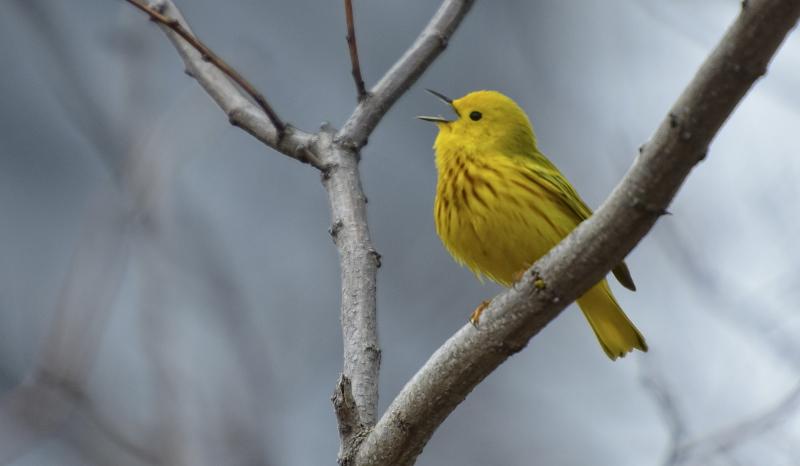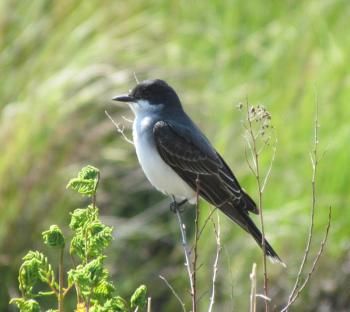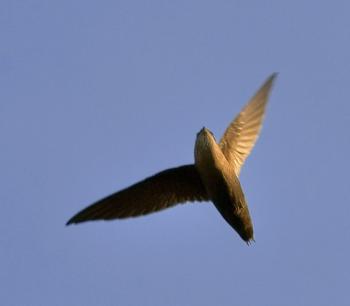All through the summer, the background noise in many a historic Maine town (for those paying attention) is the constant chittering of chimney swifts overhead. These sooty brown-colored “flying cigars” build nests inside brick chimneys, gluing together little twigs with their own sticky saliva. The sound and presence of chimney swifts is so omnipresent—all day, every day in June and July—that even avid birders don’t always make note of their presence.
In late July and the first days of August, the observant birder may note larger flocks of the birds chattering even more noisily. Sometimes we see 20 or 30 whirling about—apparently the young birds raised nearby joined with the adult birds from the area.
And then, suddenly, maybe in the second or third week of August, you step outside into the yard in the morning and there is no chittering swarm zipping across the blue sky. At first maybe you think that you just happened to miss them. But later in the day, it’s still quiet. The next day the same, and the next and the next.
The chimney swifts have left. Sure, you may see a few more in migration, silently winging by. But most (at least from our area) are headed south across the U.S., and eventually will cross the Caribbean or Central America to their wintering grounds in South America.
There are other species that kept many of us company all summer who we’ve also said goodbye to until next spring.
The “sweet, sweet, sweet, I’m so sweet” of the glorious bright yellow warbler is such a welcome sound starting in early May (sometimes even late April) when they begin returning to become one of the common and widespread birds in much of the state. They are also one of the earlier warblers to begin migrating starting as early as July and through August. Their songs become less likely to be heard after mid-July, but birds may be seen in shrubby areas often near water. We had a few puttering around our backyard into early August. And then they too were gone. Again, birders carefully looking through warblers, especially along the coast, will find a few into September and rarely in to October, but most are quickly on their way to wintering grounds as far south as South America.
We mourned (as we do each end-of-summer) the seemingly sudden disappearance of eastern kingbirds in August. Kingbirds are famous for noisily patrolling their territories in the trees and shrubs along rivers, streams, and lakes. As we’ve written about in a past column, when a crow, raven, hawk, eagle, or osprey gets too low near their territory, these spirited black and white birds, smaller than a robin, show no fear in flying up and trying to attack and drive away any of these larger birds. Determined kingbirds have occasionally been seen on the back of an eagle, pecking at the giant bird’s back and head while making a loud chattering. The big birds enduring this pesky attack probably view it a bit like we humans do a pesky fly—it’s not going to really hurt you but its annoying.
By mid-July, eastern kingbird babies have left the nest and are loudly begging for food from their parents, wandering farther and farther from the nest location. The adults are also still noisy and continue to attack any large bird that they think may be a danger to their young.
And then, sometime in the early days of August, you become aware that you haven’t heard those kingbird calls for a while. Was it last week? They are headed south like the billions of other migratory birds that share our landscapes for the warm months and then depart south beginning in late summer. Eastern kingbirds, like chimney swifts and yellow warblers, end up in South America for the winter. They’ve got a long and perilous journey ahead of them. We are sad to see them go. Good luck on your travels, our bird friends. We can’t wait to see you next year!
Jeffrey V. Wells, Ph.D., is a Fellow of the Cornell Lab of Ornithology and Vice President of Boreal Conservation for National Audubon. Dr. Wells is one of the nation's leading bird experts and conservation biologists. He is a coauthor of the seminal “Birds of Maine” book and author of the “Birder’s Conservation Handbook.” His grandfather, the late John Chase, was a columnist for the Boothbay Register for many years. Allison Childs Wells, formerly of the Cornell Lab of Ornithology, is a senior director at the Natural Resources Council of Maine, a nonprofit membership organization working statewide to protect the nature of Maine. Both are widely published natural history writers and are the authors of the popular books, “Maine’s Favorite Birds” (Tilbury House) and “Birds of Aruba, Bonaire, and Curaçao: A Site and Field Guide,” (Cornell University Press).






























